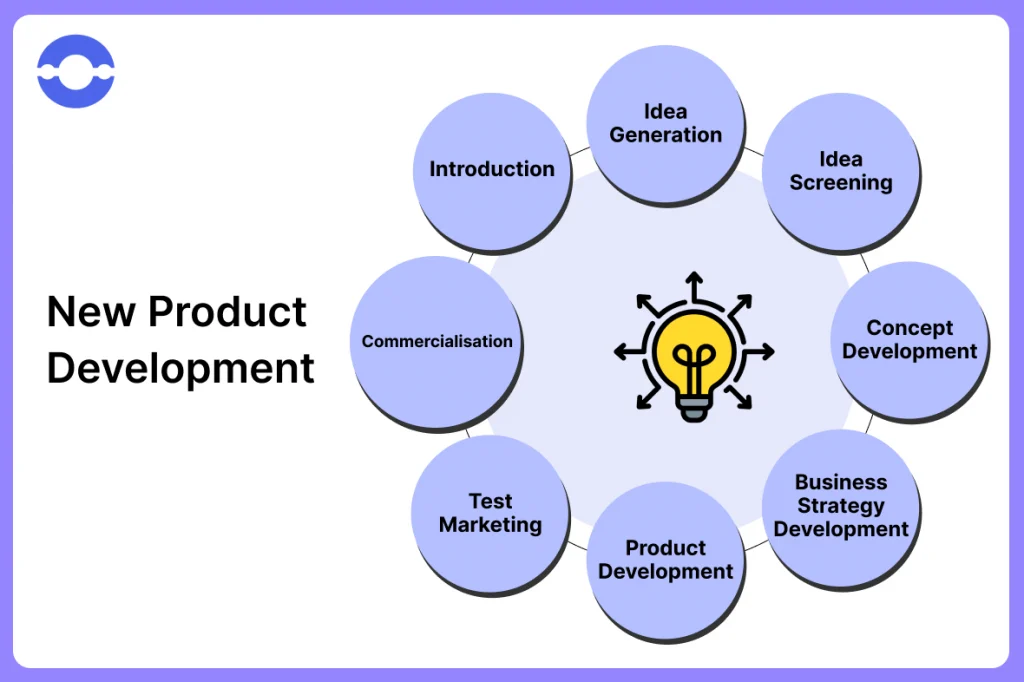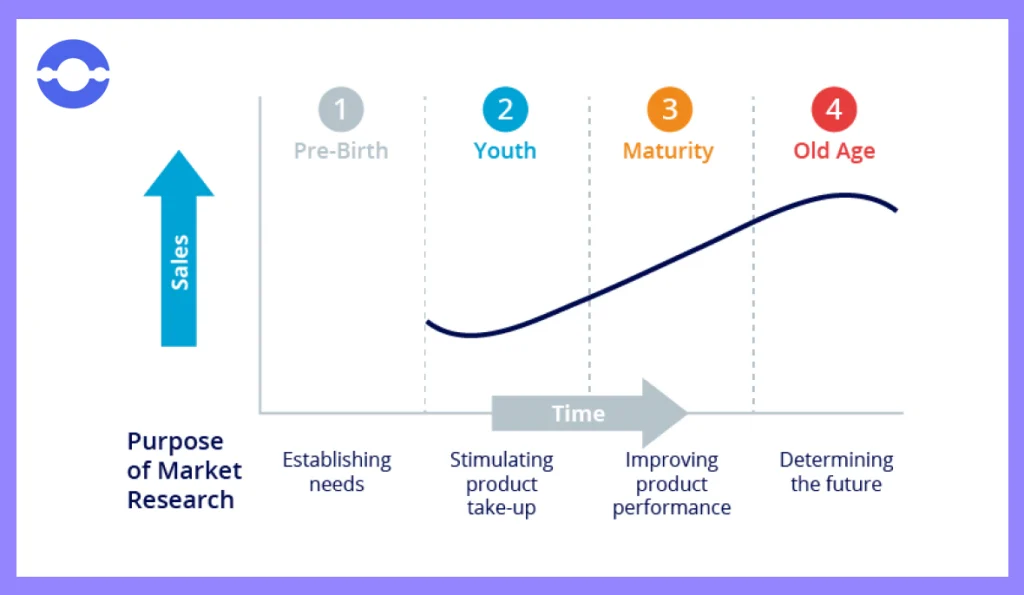
Clayton Christensen (Professor at Harvard) says that around 30,000 products are introduced yearly, and 95% fail. If your product does not meet customer needs, it will fail. If the product fails, the company will fail. Such startups/ companies fail because they create an offering for which there is no need in the market. So, your business needs to get familiar of various types of product development strategies.
As new products hit the market, the need to create an innovative product comes.
You may have had the best product ideas and did research from your side, but it would fail if you didn’t have a compelling product development strategy.
A recent US Bureau of Labor Statistics study suggests that nearly 20% of businesses fail within the first year.
Furthermore, there have been increasing cases of product failures, which account for around 40%-95%, and altogether, there are four reasons behind it–
- Lack of market research
- Poor product differentiation
- Your product fails to meet customer expectations
In this guide, we will explore a lot about product development strategy, types of product development strategies, and some brand-new examples that will help you create an effective product strategy for your business.
What is a Product Development Strategy?

Product development strategy involves developing a plan for introducing new products to the market or improving the existing ones.
The goal behind implementing a product strategy is to:
- Improve product sales
- Drive business growth
- Enhance the customer experience
It doesn’t matter if you have a successful product; having a product development strategy is important for growing your business.
Product development strategy is the subset of corporate strategy. Formulating such a strategy helps businesses to get a competitive advantage because they can place their products in the best possible way.
Every product, be it a piece of software moisturizer or a car, goes through various stages of development.
A product development strategy is essential for turning a product idea into a commercial offering.
By creating a product strategy, you can amplify the sales of an existing product and reduce the risk factor in the early stages of product development.
Consider a product development strategy as the comprehensive process covering the entire product development process ranging from ideation to product launch.
Product development strategy is about laying out the actions, processes, methods, and different activities to help you develop and launch a new product in the market.
You must have a clear product vision to create a product development strategy. Every business has a unique product vision, which explains the bigger picture for everyone. A product vision clearly defines why the product should exist.
But it doesn’t define how a business can turn a dream into a reality. This is where product development strategy comes into the picture.
Types of Product Development Strategies

Strategies for product development are broadly categorized into 2 types-
- Proactive strategies
- Reactive strategies
1. Proactive Product Development Strategy
It is a strategy where the company identifies customers’ needs and tries to launch innovative products before competitors.
Here, businesses gather information by doing market analysis, customer research, and looking at competitors’ strategies.
Here’s what companies do in proactive product development strategy-
a. Investment in Market Research

Companies using proactive market strategies are performing market research to identify customers’ needs and then developing products that meet the needs of customers.
By observing current trends in the market, businesses gain additional insights into identifying opportunities for creating new products.
Apple, for instance, is one of the leading companies in the technology arena, which conducted overall market research to understand its customer needs and came up with innovative products.
The company tries to fulfill the needs of technology users by having an online community known as “Apple customer pulse.” Such communities help Apple improve its existing products and see whether there is an idea to launch new products.
b. Investment in Research and Development (R&D)

Many product-based companies focus on launching technically superior products.
Adding unnecessary features to a product is not worth it if it does not benefit the end users. Investment in R&D helps companies get various insights into improving existing products and gain a significant competitive advantage.
According to Business Queensland, businesses that invest in R&D development are more likely to succeed in the future than businesses that don’t have.
Creating an R&D strategy results in improved productivity of businesses, improvement in products/services, more efficient processes, etc. Hence, such innovations let businesses earn higher profits in the long term.
For Instance – A spaghetti sauce brand invested in R&D and then came up with introducing original versions of products such as “Chunky Garden,” “Four Cheese,” “Tomato Garlic Garden,” etc.
c. Investment in Entrepreneurship
Another type of product development strategies is investing in entrepreneurship, which is a willingness to take risks. It’s primarily an initiative where startups and established corporations allow employees to work on their inventions.
For Instance – Google actively uses this strategy by allowing its employees to devote 20% of their time to personal development projects and 80% to their work tasks.
To their surprise, the company released 2 successful products – Gmail and AdSense which brought them huge revenue.
d. Alliances
Creating Alliances is a good strategy for businesses to ace their product development efforts. By entering alliances or strategic partnerships, companies can gain a competitive advantage in the industry and access resources or expertise they don’t have.
Apple, for example, enters alliances with other corporations such as LG Electronics, Samsung Electronics, and Panasonic Corporation of North America. Such collaborations help Apple leverage new technologies, create better products, and improve the user experience on devices.
2. Reactive Product Development Strategy
Companies create reactive product development strategies by adapting to changes in the environment. Such responses usually occur when there are technological advances or when new players are entered into the industry.
Here’s what the company does in a reactive product development strategy-
a. Responsive Strategy
It is a strategy wherein the company makes significant product improvements by listening to customer requests and feedback. Because of the close relationship with existing customers, the company knows what’s in demand or what customers request.
Usually, such a strategy for product development might not always work out because customer requests are made for features, they don’t need.
For example – When Microsoft came up with a product called “The Surface RT tablet” the company reacted to Apple’s iPad because such device dominated the tablet market.
Microsoft’s product flopped in the market because it did not have such features as the I-pad.
b. Imitation
Creating strategies by copying competitors is an old-school thought, and it’s also relevant in today’s time.
Generally, people try to underappreciate the concept of imitation in today’s business world.
But did you know that the leading brands such as Coca-cola, MC Donald, Visa, and Mastercard imitated their competitor’s strategy?
Also, such companies surpassed the original products and had tremendous success.
Another example of an Imitation product strategy is that Amazon launched an Echo product in 2016, a personal home assistant where people would ask Alexa questions such as “whether it’s hot outside.”
A year later, Google also jumped into the intelligent assistant game by launching a home assistant product, popularly known as “Google Home,” that lets people listen to everything they do.
Undoubtedly, Google shamelessly copied the concept, and got a huge success.
c. Defensive Strategy
Under a defensive product development strategy, companies intend to protect their market share and actively make it difficult for new players to enter the market.
An instance of this would be that Amazon reduced the price of Kindle Fire tablets from $199 to $159.
Such a strategy makes it challenging for competitors like Google and Apple to enter the tablet market because they were forced to lower their prices. Instead, other companies would try not to compete on prices and concentrate on other areas.
Examples of Product Development Strategies
If you are wondering to know ways by which you can create a product development strategy, here are some brand-new examples for you –
1. Change in Existing Product or Service Idea
It is a great strategy you can learn from Nissan, wherein the company makes smart moves by differentiating its products from the competition and responding to customer demands.
Nissan performed a market research analysis where they noticed the increasing gas prices and environmental concerns among customers. Then, they introduced an electric vehicle and successfully sold around 4 lakh Leaf vehicles till 2019. This is how this car manufacturer positioned itself.
2. Changing Your Product to Make it More Appealing to Customers

Through market research and customer feedback methods, the company learned that they needed to modify their existing products and work on creating a better version of them.
A popular example of a brand that creates a customer-centric strategy is Coca–Cola.
As Coca-Cola is always concerned about its customers’ needs, it comes up with refining its drinks to align with customers’ taste buds.
They understood that the market was becoming more health conscious, so they launched new variants of products such as Diet Coke and Coke Zero products with minimal or no sugar content.
3. Increase Your Product Value by Offering Better Deals to Customers

Suppose there are 2 players operating in the industry, and both are selling similar products. In that case, they need to distinguish themselves and offer a perceived value for customers by doing 2 things – either offering more variety or lowering the prices of products.
Consider an example of IKEA company, a home furniture brand that provides furniture products at affordable prices to customers. IKEA does so as it deals in bulk buying and selling of products at accessible prices.
Wrapping Up
This guide gives you exclusive access to various types of product development strategies.
REMEMBER! Creating strategies for product development starts with doing overall market research.
But you can stay on top of other brands when you research from your side and take customer feedback to identify customer requirements.
We want you to be able to select a strategy easily because we have figured this out for you.
Choose a Proactive Product Strategy in These Cases-
- When you’re trying to enter a new market
- You have enough resources to launch new products
While reactive strategies are appropriate for you in some instances-
- You want to focus on existing products
- Your business operates in a small market
- You cannot safeguard your innovations through patents
Still, if you have any doubts, share your vision and product development roadmap with us. We are here to guide you at every stage of product development journey.
At BigOhtech, you can leverage the expertise of our product managers, who are there to help you transform your product idea into a live product.
So, let’s not waste your time and connect with our product managers now.




